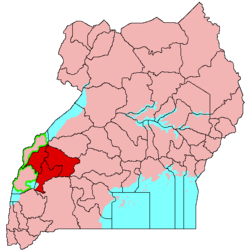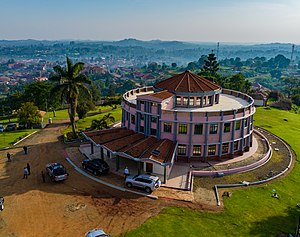| This article needs additional citations for verification. Please help improve this article by adding citations to reliable sources. Unsourced material may be challenged and removed. Find sources: "Tooro Kingdom" – news · newspapers · books · scholar · JSTOR (February 2024) (Learn how and when to remove this message) |
| Kingdom of TooroObukama bwa Tooro (Tooro) | |
|---|---|
 Flag
Flag | |
| Anthem: "Agutamba" | |
 Location of Toro (red) in Uganda (pink). Location of Toro (red) in Uganda (pink). | |
| Capital | Fort Portal |
| Official languages | Rutooro, English |
| Ethnic groups | many ethnicities but the indigenous are; Batooro, Bakonzo, Babwisi, Bamba |
| Demonym(s) | Tooro |
| Government | Constitutional monarchy |
| • Omukama | Rukidi IV |
| • Omuhikirwa (Prime Minister) | Steven Kiyingi |
| Independence | |
| • from the Kingdom of Bunyoro | 1830, 1876 |
| • Monarchy abolished | 1967 |
| • Monarchy reinstated | 1993 |
| Currency | Ugandan shilling |
| Time zone | UTC+3 (EAT) |
| Calling code | 256 |
| Tooro | |
|---|---|
| Person | Omutooro |
| People | Abatooro |
| Language | Orutooro |
| Country | Obukama bwa Tooro |



The Tooro Kingdom is a Bantu kingdom located within the borders of Uganda. The current Omukama of Tooro is King Oyo Nyimba Kabamba Iguru Rukidi IV. King Oyo Nyimba Kabamba Iguru Rukidi IV took to the throne of Tooro kingdom in 1995 at the age of just three years, after the death of his father Omukama Patrick David Matthew Kaboyo Rwamuhokya Olimi III on August 26, 1995, at the age of 50.
The people native to the kingdom are the Batooro, and their language is likewise called Rutooro. The Batooro and Banyoro speak closely related languages, Rutooro and Runyoro, and share many other similar cultural traits. The Batooro live on Uganda's western border, south of Lake Albert.
History
The Tooro Kingdom evolved out of a breakaway segment of Bunyoro sometime before the nineteenth century. It was founded in 1830 when Omukama Kaboyo Olimi I, the eldest son of Omukama of Bunyoro Nyamutukura Kyebambe III of Bunyoro, seceded and established his own independent kingdom. Absorbed into Bunyoro-Kitara in 1876, it reasserted its independence in 1891.
As with Buganda, Bunyoro, and Busoga, Tooro's monarchy was abolished in 1967 by the Government of Uganda, but was reinstated in 1993.

Cultural influence
Main articles: Friedensreich Hundertwasser and EmpaakoThe Austrian painter Friedensreich Hundertwasser (1928–2000) spent some time there in the 1960s where he painted a number of works and named them after the kingdom.
The Batooro people have a strong culture but similar in stratification to Banyoro. They have got a strong cultural naming system (PET NAME) known as Empaako. With the Empaako naming system, children are given one of twelve names shared across the communities in addition to their given and family names. Addressing someone by his or her Empaako is a positive affirmation of cultural ties. It can be used as a form of greeting or a declaration of affection, respect, honour or love. Use of Empaako can defuse tension or anger and sends a strong message about social identity and unity, peace and reconciliation. The Empaako names are: Amooti, Abbooki, Akiiki, Ateenyi, Adyeri, Atwoki, Abwoli, Araali, Acaali, Bbala, and Okaali.
Abakama ba Tooro (Kings of Tooro)
The following is a list of the Abakama of Tooro since 1800:
- Olimi I: 1822–1865
- Ruhaga of Tooro: 1865–1866
- Nyaika Kyebambe I: 1866–1871 and 1871–1872
- Rukidi I: 1871
- Olimi II: 1872–1875
- Rukidi II: 1875–1875
- Rububi Kyebambe II: 1875 and 1877–1879
- Kakende Nyamuyonjo: 1875–1876 and 1879–1880
- Katera: 1876–1877
- Interregnum, reverted to Bunyoro: 1880–1891
- Kyebambe III: 1891–1928
- Rukidi III: 1929–1965
- Olimi III: 1965–1967 and 1993–1995
- in pretence: 1967–1993 (monarchy abolished)
- Rukidi IV: 1995–present (monarchy reinstated)
See also
Bibliography
- Ingham, Kenneth. The Kingdom of Tooro in Uganda. London: Methuen, 1975.
Notes
References
- ^ "Today in History: Toro king passes on". www.newvision.co.ug. Retrieved 2020-05-30.
- ^ "The Kingdom of Toro". www.torokingdom.org. Archived from the original on 2020-08-12. Retrieved 2020-05-30.
- ^ Turyahikayo, B. (1976). "Review of A Dynastic History "The Kingdom of Toro in Uganda"". Transafrican Journal of History. 5 (2): 194–200. ISSN 0251-0391. JSTOR 24520247.
- "Uganda Batoro - Flags, Maps, Economy, History, Climate, Natural Resources, Current Issues, International Agreements, Population, Social Statistics, Political System". photius.com. Retrieved 2020-05-30.
- "Hundertwasser - One Toro in the Kingdom of the Mountains of the Moon". hundertwasser.com (in German). Retrieved 2024-01-25.
- "Kingdom of the Toro von Friedensreich Hundertwasser auf artnet". Archived from the original on 2020-07-31.
- ^ "UNESCO - Empaako tradition of the Batooro, Banyoro, Batuku, Batagwenda and Banyabindi of western Uganda". ich.unesco.org. Retrieved 2020-05-30.
- ^ "Empaako Ceremony, Origin and meaning". The Ugandan. Retrieved 2020-05-30.
- ^ "Home". Cross-Cultural Foundation of Uganda. Retrieved 2020-05-30.
- ^ BigEyeUg3 (2015-11-02). "Pet Names (Empaako) and Their Meaning". BigEye.UG. Retrieved 2020-05-30.
{{cite web}}: CS1 maint: numeric names: authors list (link)
External links
| Kingdoms |
|
|---|---|
| Chiefdoms | |
| See also: List of current constituent monarchs in Uganda | |
This Uganda location article is a stub. You can help Misplaced Pages by expanding it. |